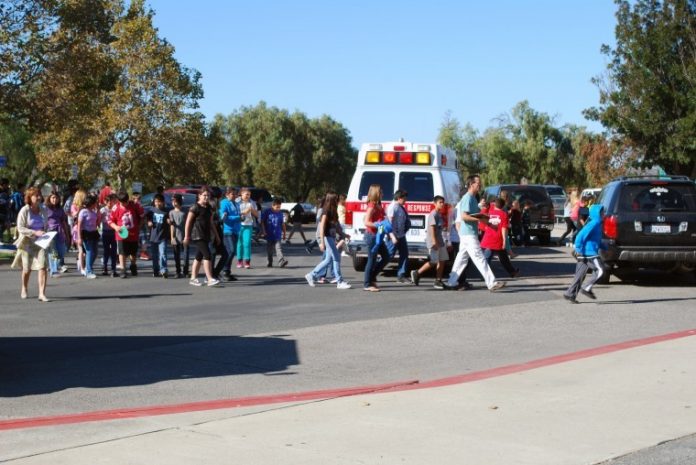
Sunnyslope Elementary School officials and local law enforcement agencies went through the steps they would take if a major earthquake were to hit the school as part of the Great California Shake Out on Thursday.
More than 9 million people participated statewide in the annual event, including other local schools that held level 2 drills, in which students practiced the duck-and-cover technique.
At Sunnyslope Elementary School, Principal Bill Sachau and Hollister School District Superintendent Gary McIntire worked with law enforcement groups to create a scenario that would challenge everyone involved.
Before the event began, McIntire said the school officials had already realized an issue with their evacuation process. The school has a turnaround area where parents turn in to pick up or drop off students, which is the same place where emergency vehicles would arrive.
“It’s a dry run for the logistics,” McIntire said. “Every time we practice under non-stressful circumstances – there are going to be things we don’t imagine or won’t go as smoothly. The more we test, they more we will discover.
Hollister Fire Capt. Charlie Bedolla helped the school officials plan the drill, and they briefed together via phone Thursday morning before starting the drill.
At 10:18 a.m. Thursday, in conjunction with 14.5 million people worldwide, Sachau got on the loud speaker at his school and started the drill. Over a public announcement system, Sachau verbally walked the students through what would happen in an actual large earthquake.
“The building is creaking,” he said. “The windows are rattling. Books are falling off the shelves. Potted plants are swinging.”
In the classrooms, the students practiced the duck and cover, waiting for the principal to clear them to evacuate the buildings.
Sachau called in the emergency over 911, making sure to indicate it was part of a drill. Within minutes, the first fire engine showed up on scene. As in a real emergency situation, the first crew on site assigned an incident commander who was responsible for managing the event.
Sachau had arranged for four people on campus to play victims injured in the earthquake. Rescue workers had to go into the school to find the teacher, two students and a maintenance worker who all had faux injuries. They retrieved the victims from the rooms and moved them to a staging area near the front of the school, where paramedics dealt with them before turning them over to a triage area.
By 10:50 a.m., Sachau released the students to return to their classrooms and the emergency personnel gathered under a shade tree to debrief about the drill. Everyone involved acknowledged that in a major earthquake situation the number of emergency personnel who participated in the Sunnyslope School drill would be a stretched as services would likely be needed around the entire city.
A sheriff’s deputy suggested the Hollister School District compare its emergency protocol to that recommended by the county’s Office of Emergency Services. Deputy Jason Leist, the school resource officer at San Benito High School, said HSD could also compare notes with San Benito High School. He suggested a common protocol for all the campuses.
In terms of logistics, the school officials realized quickly that they would need to rethink the areas where kids are evacuated since some of them were evacuated to a grassy area in a parking lot, near the staging area for law enforcement. They also talked about possibly moving the evacuation area to Veterans Memorial Park, which would also facilitate parent pick up in an emergency situation.
“We can look through the eyes of emergency responders,” McIntire said, of the insight gained from the drill. “We know you guys will be all over and we will need to hunker down as much as possible.”
McIntire said the schools would rethink the emergency backpacks they have so they have the most useful supplies.
They also talked about how to communicate if landline and cell phones are not working, with someone suggesting radios.









